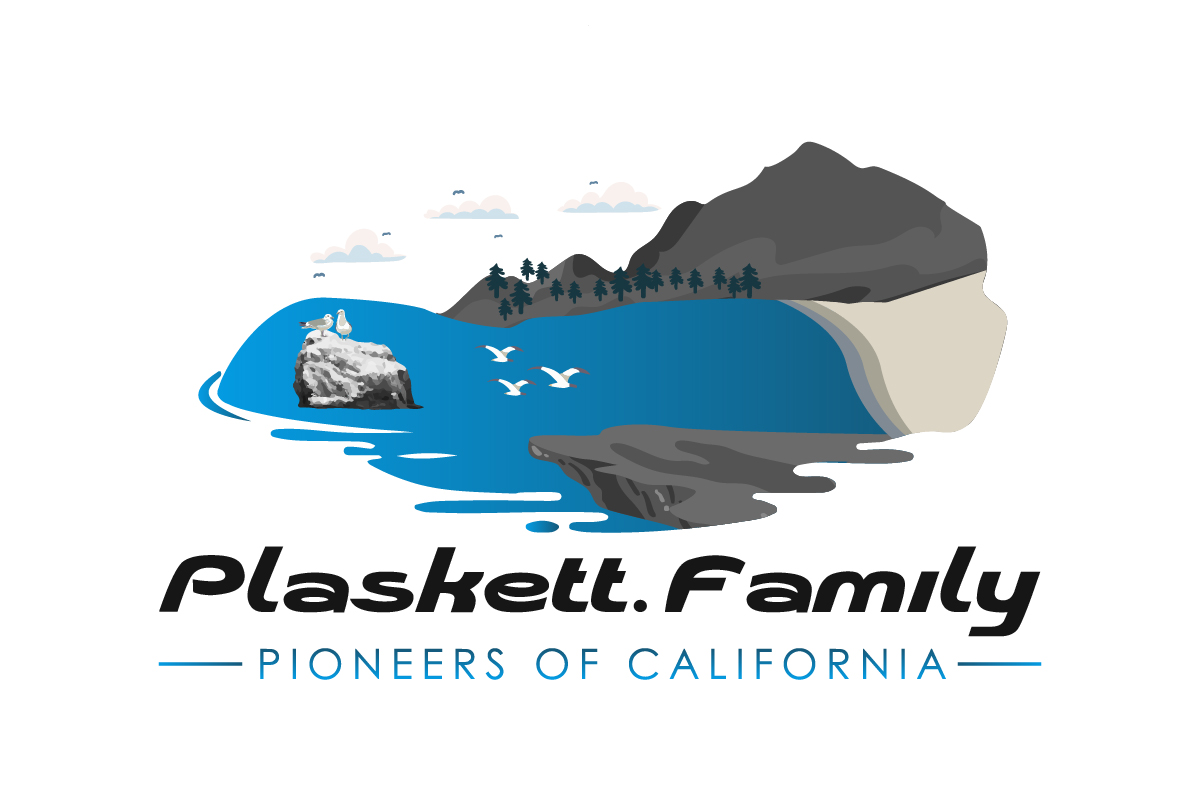Prized Possession of the Coast Are Its Big Trees
By Mabel Plaskett
“The big trees and coast redwoods of California are the largest and oldest of living things.”
My earliest memories are of playing house with my brothers and sisters in a hollow redwood in Mill Creek large enough for the five of us with a deep carpet of dried redwood leaves. Here we were warm and snug through rain and thunder storms.
In clear weather we wandered along the creek under the great trees so close together the sun penetrated it only in patches. Walking on the deep carpet beneath the trees where the silence is broken only by the soft murmur of the nearby stream or an occasional twig snapping, one has a feeling of deep reverence never to be forgotten.
The redwoods are one of our most precious possession and we who live among them are justly proud. The coast redwood (Sequoia Sempervirens) grows in the coast range of California from southern Oregon to Southern Monterey County always within the coastal belt of sea fogs. These trees have a base diameter up to 16 feet and are taller than their sierra cousins. The Founder Tree in the Humboldt Redwood State Park is the world’s tallest tree stretching 364 feet high.
MANY GROVES of coast redwood had been nearly destroyed by ruthless cutting for lumber before the forest conservation laws were enacted.
The Spanish padres of Portola’s Expedition probably first saw the redwoods in 1769 along the coast of California. They called the trees “Palo Colorado” because of the red color of the heart wood.
In 1823 A. B. Lambert, an English botanist, gave them a scientific name by placing it in the same genus as bald cypress “Taxodium Sempervirens.”
In 1847 Steven Endlicher, an Austrian botanist, studied the specimen and renamed it Sequoia Sempervirens.
The giant sequoia was not discovered until 1833 when Captain Joseph Walker’s party on their way from Salt Lake to Monterey sighted them. Zenas Leonard, clerk of the expedition, wrote: “In the last two days traveling we have found some trees of the Redwood species incredibly large—some of which would measure from 16 to 18 fathoms around the trunk at the height of a large man’s head from the ground.”
No doubt the grove seen by the Walker party was either the Merced or the Tuolumne.
THE CALAVARAS grove was discovered in 1841 by John Bidwell, but it was not until 1852 when A. T. Dowd, a hunter of Murphy’s Camp, rediscovered the Calavera’s Grove that the Sequoia Gigantea became generally known. These monarchs of the forest occur in the west slope of the Sierra from the American River in Placer County on the north to Deer Creek in Tulare County on the south between elevations of 4,000 to 8,500 but generally on 5,000 to 7,000 elevation.
The distinction between the two Sequoias are size—the Coast Redwood attaining a maximum diameter of 16 feet while the Big Tree reaches 30 feet or more. The Redwood is taller and more graceful and occurs in heavy forest stands while the Big Tree occurs in isolated groves. Also the big Tree does not send out sprouts at the roots as the Redwood does and is propagated only by seed.
The foliage of the Coast Redwood is in the form of two-ranked needles like the hemlock and the Big Trees have scale like foliage resembling the junipers.
The cones and seed of the giant sequoia are about three times the size of that of redwoods.
There are about 72 groves of Giant Sequoia known, many of them almost inaccessible.
THE LARGEST groves are in Sequoia National Park where General Sherman Tree (the largest living thing on earth) stands. This tree is 272.4 feet in height, 102 feet perimeter at base and 30.7 feet in diameter at base. It contains 600,120 board feet of wood. To protect the shallow root system from damage from trampling on the thousands of yearly visitors a barrier has been built around the tree. Log seats invite the visitor to sit in restful contemplation among these giants of the forest, centuries old.
The sequoias are a link between the past and the present. They hark back to Eocene or earlier times where trees and reptiles were gigantic. The age of mammoth saurian passed and the age of mammals dawned. The dinosaurs have gone, but the sequoias remain.
There was a time when the sequoia genus was spread over four continents. Only two species survived the Glacial age and both are limited to California.
Fossilized trunks of sequoia still stand in Miocene deposits in Yellowstone National Park. Dr. Ralph Chaney has found in Oregon the foliage of sequoias which existed millions of years ago and identical with that of today.
In 1940 living plants of the Dawn Redwood “Metasequoia” were found in China and are now grown in this country.
THE ENEMIES of sequoias are fire, wind, water erosion and destructive acts of man. Because of the large tannin content of its wood they are practically immune to fungus disease or insects and are highly fire resistant.
Seldom has a large sequoia been killed by a single fire. In every grove can be seen scars from burns and many tops of the trees show signs of being struck by lightning. One tree in the Giant Forest of Sequoia National Park has a shattered crown, a large crack extending down the trunk, but the tree still lives. Their power of recuperating is great.
After the bark is burned, the cambian at once begins to grow around the scarred areas in an attempt to close the wounds. They are called indestructible and well they might be. John Muir who named Giant Forest, states he found a tree in the Converse Basin Grove 4,000 years old.
Trees such as the General Grant, Grizzly Giant, General Sherman and the Boole must be over 3,500 years old. They, as well as The President, the Abe Lincoln and George Washington tree all are approximately 30 feet in diameter and could be 4,000 years old or more. The age limit of the Big Tree is unknown because there is no record of any dying of old age.
THE NAMING of the sequoia was appropriate. The name was given by Steven Endlicher, an Austrian botanist who was also a linguist and a student of American history. When Endlicher decided the tree was not a Taxodium, but a new genus hitherto unnamed he thought of a Cherokee Indian named Sequoyah who had prepared an alphabet of 85 symbols for his people and he felt the great Red Man should be honored by having the Great Red Trees named for him.
This classification was generally accepted by botanists. In 1828 Sequoyah came to Washington as a representative of the Western tribes of Indians and Congress recognized his alphabet and made an appropriation of $500 in appreciation of his work.
In 1917 a statute of Sequoyah was unveiled in Statuary Hall in Washington. Thus a great American Indian has a monument on each side of the continent—his statute in Washington and countless living trees along the coast and in the Sierra.
At Giant Forest a rugged old tree has been named Chief Sequoia. Providence has spared a few scattered groves of these trees that once covered a large part of the world and it seems fitting they were left in America where they may be preserved for all people for all time in our National Parks.
Here in the deep canyons of our own coastland we count it a privilege to walk along the streams under the redwoods, on a soft carpet of redwood leaves often several feet deep, and with the woody fragrance of the trees, the stillness all around, one feels they are indeed “a link with eternity.”
“Here and there they have set aside a few old trees with arms held wide
To the winds of God;
And the reverent hears the whispering tongues of a thousand years.”—Reese.

Mabel Sans Plaskett was born in Coralitas near Ben Lomond in the Santa Cruz Mountain area of California. Her father Edward Robert Sans ran a saw mill near Pacific Valley, along the Nacimiento – Ferguson road to the coast at Highway One. It was there she met Edward Abbott Plaskett, her husband. Mabel wrote about the coast and the pioneers of the 19th and 20th Centuries.

Recent Comments